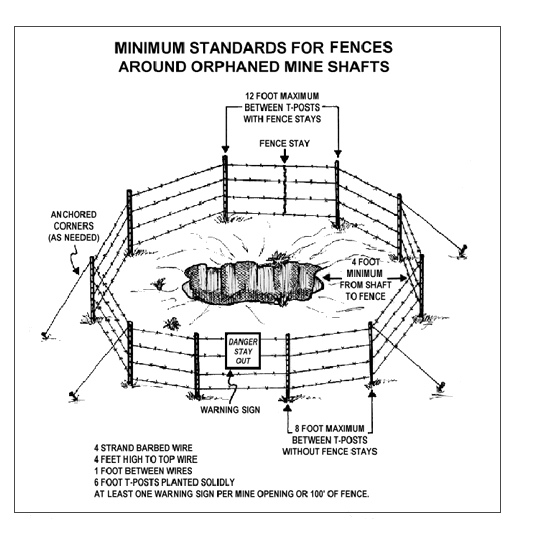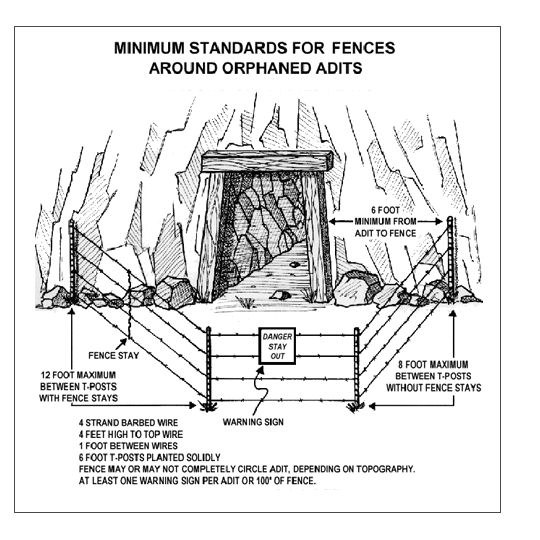Frequently Asked Questions
General
Based on our work we estimate there are 100,000 abandoned mines in the State of Arizona.
Many of the old mines were worked in the late 1800's through the 1940's. When the mines played out, or the market for metals got bad, the miners simply walked away in search of richer finds elsewhere. Even on mines that were patented (sold to the miner by the government) the original owners are long dead. Their descendents often don't know what they own or the mine has been sold for taxes or repossessed by the state.
Arizona Revised Statute §27-318 states: Every mine operator or former mine operator or claimant who owns a mine or mining claim or possess a mine or mining claim under lease, contract, permit or otherwise, who knowingly permits the existence on the premises of an abandoned or inactive mining shaft, portal, pit or other excavation which is dangerous to persons legally on the premises, who fails to cover, fence, fill or otherwise secure it and post warning signs, within sixty days of notification by the inspector and who fails to keep it so protected is guilty of a class 2 misdemeanor. This means that anyone owning a mine must keep it fenced and have warning signs posted. There are no requirements for the type of fence or sign but the following are recommendations based on the standard used in Nevada.


In general the stock probably is not worth anything. If the company listed on a stock certificate was incorporated in Arizona or the Arizona Territory, you can determine if the company is still active, or how and when it became inactive, by calling the Arizona Corporation Commission at 602-542-3026. They provide basic information on incorporated companies. You may obtain this information by sending a fax detailing the company to the Arizona Corporation Commission at 602-542-3414.
If the company is inactive or the stock cancelled, an original certificate in good condition may still be of trivial value to collectors of mining memorabilia.

Since 1992, over 10,000 mines have been inventoried and mapped. Many of these openings are shallow prospects, but many others are dangerous shafts and tunnels.
Several hundred mines have been fenced by the abandoned mines program since the late 1990's. In addition ten openings have been permanently back filled and five bat gates have been constructed by the program.
Given the right circumstances, any mine, no matter how shallow, can be perilous. The hazardous rating of an inventoried mine is based on summation of sixteen ranking parameters. If the resulting score of a mine is over a certain level, then the mine is deemed a "Significant Public Hazard." Roughly 13% of the mines inventoried in the last eight years have received this designation. This means approximately 1,200 of the mines assessed pose an extreme risk to public safety.
Field personnel carry warning signs and tape and post them at mines whenever possible. Deputy Mine Inspectors visit all unprotected abandoned mines reported to the office. They post warning signs and tape off dangerous openings. The owners are then notified of their responsibility for keeping the mine fenced to protect the public. If no owner of record is found, the Deputy Mine Inspectors will erect a fence around the opening.
Prior to closing a mine the following must be determined with the help of the State Land Department:
- Is the mine on State Land? If not, it is referred to the proper federal agency if it is on federally managed lands or, if on private land, the owner is ascertained through federal and county records.
- If the mine is on State Land, does it have an active lease or claim? If it does not, the closure may proceed. If it does, the lessor must be required to fence the mine and post warning signs.
- What is the history of the mine? The Department of Mines and Mineral Resources (ADMMR) must be contacted for a copy of the mine's history. The State Land Department arranges for the State Historical Preservation Office to assess the mine site. This agency also has their archeologists conduct a study of the site, and determine the impact of the closure on the cultural resources of the mine.
- Are there any endangered species living in or around the mine that would be impacted by a closure? The Arizona Fish and Game Department must be contacted to assess the mine openings for bats and other endangered species. Endangered and threatened plants must also be assessed for possible impact by mine closure.
- Is there any potential for future renewed mining of the site? ADMMR's history files and a site investigation by a geologist or mine engineer is the best way to determine future potential.
- Given the above considerations, what is the best type of closure for the mine? A mine with sensitive species or potential future use should be closed using a bat gate or other semi-permanent closure. Mines without these can be filled or capped to fully protect the public.
Reclamation FAQ
Reclamation means measures that are taken on surface disturbances at exploration operations and aggregate mining units to achieve stability and safety consistent with post aggregate mining land use.
No. The Mine Inspector is a health & safety agency that works to ensure the health and safety of people working at mines, coordinate the closure of abandoned mines that pose a threat to public safety, and ensure that lands used for mining on privately owned property with a surface disturbance greater than 5 acres are properly reclaimed for public use once mining is completed.
No.
Since April 1997, the Arizona’s Mined Land Reclamation Act (A.R.S. § 27-901 et. seq.) and the rules per Arizona Administrative Code (A.A.C. R11-2-101 et. seq.), requires all metalliferous mines with surface disturbances on private land greater than five acres to submit reclamation plans and financial assurance mechanisms to the State Mine Inspector for review and approval
In 2005, the Aggregate Mined Land Reclamation Act became the responsibility of the Arizona State Mine Inspector. Under the 2005 Act, all aggregate mining sites which disturb over 5 acres of private land must submit a reclamation plan and pay fees for the review and processing of their reclamation plans pursuant to A.R.S. §§27-1201-1327. The one-time fee outlined in R11-3-210(3) covers the initial costs of the aggregate reclamation plan for administrative and technical compliance reviews pursuant to A.R.S. §§27-1221-1234.
Once a proposed reclamation plan or substantial change is submitted, it is first reviewed by the Mine Inspector’s staff to ensure that the mandated contents of the reclamation plan are administratively complete. Once the Mine Inspector’ staff has found the plan to be administratively complete, the plan is then sent to a qualified private consultant and/or engineer to ensure that the plan meets the technical criteria and requirements of the chapter and rules adopted by the Inspector. If the plan is found to be Technically Complete by the consultant, it is eligible to go through the public meeting process where adjacent private property owners are informed of the public meeting.
Once a proposed reclamation plan or substantial change is submitted, it is first reviewed by the Mine Inspector’s staff to ensure that the mandated contents of the reclamation plan are administratively complete. Once the Mine Inspector’ staff has found the plan to be administratively complete, the plan is then sent to a qualified private consultant and/or engineer to ensure that the plan meets the technical criteria and requirements of the chapter and rules adopted by the Inspector. If the plan is found to be Technically Complete by the consultant, it is eligible to go through the public notification process where the Mine Inspector gives notice of a proposed reclamation plan or substantial change to an approved reclamation plan once each week for two consecutive weeks in a newspaper of general circulation in the county where the mining unit is located.
The Annual Status Report is required each year within 60 days after the anniversary date of the reclamation plan approval.
Yes. Financial assurance is required to be submitted within 60 days after a plan is approved.
An approved reclamation plan and any approved substantial changes remain in effect until the reclamation is complete and all financial assurance is released by the Mine Inspector.
The Act requires that the responsible party be released from their financial assurance mechanism only if the Mine Inspector has approved a Transfer of the plan to a new responsible party, or submitted a Complete Closure Application.